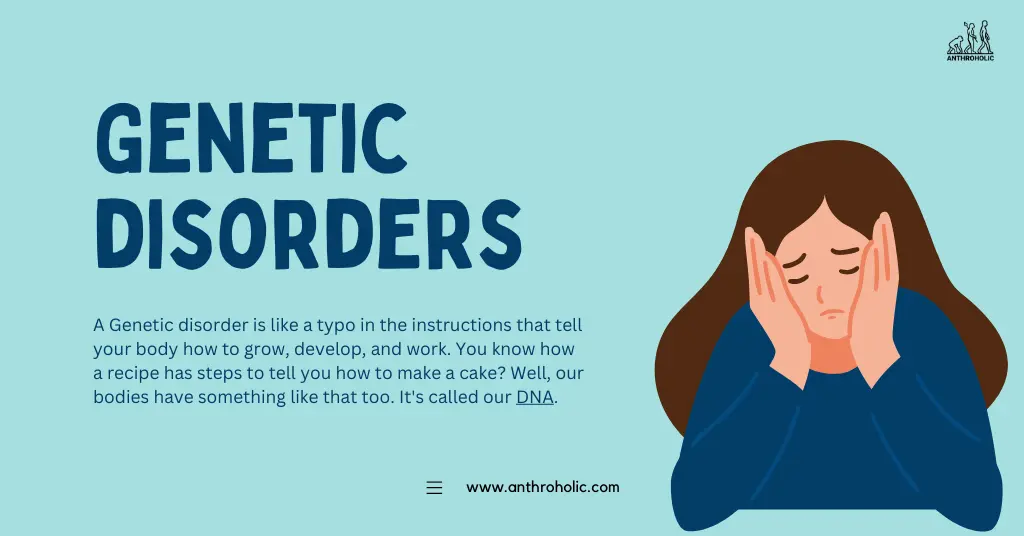AI Answer Evaluation Platform Live Now. Try Free Answer Evaluation Now
Genetic Disorder
A Genetic disorder is like a typo in the instructions that tell your body how to grow, develop, and work. You know how a recipe has steps to tell you how to make a cake? Well, our bodies have something like that too. It’s called our DNA.
But sometimes, there can be a mistake or a mix-up in this DNA recipe. This is what we call a “mutation“. It’s kind of like if someone told you to put a cup of salt in the cake instead of a cup of sugar – that would definitely change how your cake turns out, right?
Similarly, these mistakes in our DNA can cause parts of our body to not work properly, which can lead to a genetic disorder. These disorders can affect various parts of the body and can cause different types of health problems. Some genetic disorders are quite rare, and others are more common. Some can be serious and cause a lot of health problems, while others might only cause minor issues. And just like you inherit your hair or eye color from your parents, sometimes you can inherit these genetic disorders from them too. But sometimes, these disorders can also happen for the first time in a person, without being passed down from the parents.

The impact of a genetic disorder on an individual’s health can be highly variable, and depends on a multitude of factors including the specific disorder, the nature and location of the genetic abnormality, and the person’s overall health and environmental context.
What are Genes?
Genes are the fundamental units of heredity, determining various aspects of our physiology and health. They are essentially segments of deoxyribonucleic acid (DNA) located on chromosomes within the nucleus of our cells. A gene carries specific instructions that dictate how to build and maintain cells and carry out their functions.
Each gene is made up of a specific sequence of nucleotides (adenine, guanine, cytosine, and thymine), which encode for amino acids, the building blocks of proteins. Proteins, in turn, are critical for the structure, function, and regulation of the body’s tissues and organs [1]. The Human Genome Project, completed in 2003, identified approximately 20,500 human genes, but the precise number remains an active area of research [2].
How Do Genes Influence Health?
The influence of genes on health is vast, complex, and still not fully understood. As the blueprint for protein synthesis, genes directly influence the structure and function of our bodies. Proteins play crucial roles in nearly every biological process, serving as enzymes that catalyze biochemical reactions, structural components of cells and tissues, transporters for molecules, and antibodies that defend against infections, among many other roles.
Given their fundamental role in dictating our biological make-up, alterations in genes can lead to significant health impacts. Mutations, which can occur spontaneously or be inherited, can disrupt normal gene function and lead to disease. For example, a single nucleotide change in the gene that produces hemoglobin can lead to sickle cell anemia, a severe and often fatal blood disorder [3].
Types of Genetic Mutations
There are several types of genetic mutations, each with its own characteristics and implications. Here are some common types:
Point Mutations: These are the most common type of genetic mutation and involve changes in a single nucleotide base within the DNA sequence. Point mutations can be further classified into three subtypes:
- Silent Mutations: These mutations do not result in a change in the amino acid sequence of a protein due to the redundancy of the genetic code. Therefore, they usually have no significant impact on the phenotype.
- Missense Mutations: These mutations lead to the substitution of one amino acid for another in the protein sequence. Depending on the location and nature of the substitution, missense mutations can have variable effects, ranging from no impact to severe functional changes.
- Nonsense Mutations: These mutations introduce a premature stop codon in the DNA sequence, resulting in the premature termination of protein synthesis. This can lead to the production of truncated and often non-functional proteins.
Insertions and Deletions (Indels): These mutations involve the addition or removal of one or more nucleotides from the DNA sequence. Indels can disrupt the reading frame, leading to a frameshift mutation, where the entire amino acid sequence downstream of the mutation is altered.
Repeat Expansions: These mutations involve the expansion of repeated DNA sequences within the genome. This expansion can lead to abnormal protein structures or impair gene function. Examples of disorders caused by repeat expansions include Huntington’s disease and fragile X syndrome.
Chromosomal Rearrangements: These mutations involve alterations in the structure of chromosomes, such as translocations, inversions, duplications, and deletions. Chromosomal rearrangements can disrupt the normal functioning of genes and lead to genetic disorders. For example, individuals with Down syndrome have an extra copy of chromosome 21 due to a chromosomal duplication.
Chromosomal Aneuploidy: Aneuploidy refers to an abnormal number of chromosomes in an organism’s cells. Examples of aneuploidy disorders include Turner syndrome (45, X), Klinefelter syndrome (47, XXY), and Down syndrome (47, +21).
Gene Mutations: These mutations occur within a single gene and can lead to various genetic disorders. Gene mutations can be categorized into different types, including:
- Loss-of-function mutations: These mutations result in a gene losing its normal function or producing a non-functional protein. They can cause diseases such as cystic fibrosis, where a mutation in the CFTR gene impairs chloride ion transport.
- Gain-of-function mutations: These mutations lead to a gene acquiring a new function or overexpressing a protein, often resulting in abnormal cellular processes. Examples include mutations in the RET gene associated with multiple endocrine neoplasia type 2 (MEN2).
- Regulatory mutations: These mutations occur in the regulatory regions of a gene, affecting its expression. Changes in promoter regions or enhancer elements can alter gene expression levels and contribute to disorders like hereditary persistence of fetal hemoglobin.
Classification of Genetic Disorders
Genetic disorders are generally classified into four types based on the nature of the genetic defect:
- Single-gene disorders: These result from mutations in the DNA sequence of a single gene. Examples include cystic fibrosis, sickle cell disease, and Huntington’s disease.
- Chromosomal disorders: These occur when chromosomes, or large parts of chromosomes, are missing, duplicated, or otherwise misaligned. Examples include Down syndrome, Turner syndrome, and Klinefelter syndrome.
- Multifactorial inheritance disorders: These involve combinations of gene mutations and environmental factors. They include many common diseases such as heart disease, high blood pressure, Alzheimer’s disease, arthritis, diabetes, cancer, and obesity.
- Mitochondrial genetic disorders: These result from mutations in the non-nuclear DNA of mitochondria, the energy-producing structures inside cells. Examples include Leber’s hereditary optic neuropathy and mitochondrial encephalopathy with lactic acidosis and stroke-like episodes (MELAS).
Common Genetic Disorders: Case Studies
Cystic Fibrosis
What is Cystic Fibrosis?
Cystic Fibrosis (CF) is a genetic disorder characterized by the production of thick, sticky mucus that affects various organs, primarily the lungs and digestive system. It is caused by mutations in the cystic fibrosis transmembrane conductance regulator (CFTR) gene, which leads to abnormal chloride ion transport across cell membranes.
Causes of Cystic Fibrosis
Cystic Fibrosis is caused by inheriting two mutated copies of the CFTR gene, one from each parent. The CFTR gene mutations disrupt the function of the CFTR protein, leading to the accumulation of thick mucus in the lungs and other affected organs.
Symptoms and Impact on Health
The symptoms of Cystic Fibrosis can vary but commonly include persistent cough, recurrent lung infections, poor growth and weight gain, digestive problems, and salty-tasting skin. The accumulation of thick mucus in the lungs can lead to progressive lung damage, making it difficult to breathe and increasing the risk of respiratory infections. The digestive complications can cause malabsorption of nutrients and pancreatic insufficiency.
Current Treatments and Prognosis
Although there is no cure for Cystic Fibrosis, advancements in treatment have significantly improved the prognosis and quality of life for affected individuals. Treatment approaches include airway clearance techniques, medications to thin mucus and manage lung infections, enzyme replacement therapy to aid digestion, and nutritional support. Lung transplantation may be an option for severe cases. The prognosis for individuals with Cystic Fibrosis has improved over the years, with increased life expectancy and improved management strategies.
Down Syndrome
What is Down Syndrome?
Down Syndrome, also known as Trisomy 21, is a genetic disorder caused by the presence of an extra copy of chromosome 21. It is characterized by intellectual disabilities, distinct facial features, and certain medical conditions.
Causes of Down Syndrome
Down Syndrome is primarily caused by a chromosomal abnormality called trisomy, where there is an extra copy of chromosome 21. This extra genetic material occurs during the formation of reproductive cells or early development of the embryo.
Symptoms and Impact on Health
Individuals with Down Syndrome often have cognitive impairments, ranging from mild to moderate, as well as distinctive physical features such as almond-shaped eyes, a flat nasal bridge, and a single crease across the palm. They may also experience certain health conditions, including heart defects, hearing and vision problems, and a higher risk of developing certain medical conditions like leukemia.
Current Treatments and Prognosis
There is no cure for Down Syndrome, but early intervention and appropriate medical care can greatly improve the quality of life for individuals with the condition. Treatment focuses on managing associated health conditions, providing educational support, and promoting independent living skills. The prognosis for individuals with Down Syndrome has improved significantly over the years, with increased life expectancy and improved support systems.
Hemophilia
What is Hemophilia?
Hemophilia is a genetic bleeding disorder characterized by the inability of the blood to clot properly. It is primarily caused by mutations in the genes responsible for the production of clotting factors, specifically Factor VIII (Hemophilia A) or Factor IX (Hemophilia B).
Causes of Hemophilia
Hemophilia is caused by inheriting a mutated gene for clotting factors from one or both parents. The mutations result in decreased or absent production of the specific clotting factor, leading to prolonged and excessive bleeding.
Symptoms and Impact on Health
The main symptom of hemophilia is prolonged bleeding, both internal and external, even from minor injuries or trauma. Individuals with hemophilia may experience joint and muscle bleeds, spontaneous bleeding, easy bruising, and excessive bleeding during surgeries or dental procedures. Severe cases can result in debilitating joint damage.
Current Treatments and Prognosis
There is no cure for hemophilia, but treatment focuses on managing bleeding episodes and preventing complications. This is achieved through the administration of clotting factor replacements, either as preventive therapy or during bleeding episodes. Physiotherapy and joint care play a crucial role in preventing joint damage. With appropriate treatment and management, individuals with hemophilia can lead active and fulfilling lives.
Sickle Cell Disease
What is Sickle Cell Disease?
Sickle Cell Disease (SCD) is a group of inherited blood disorders characterized by abnormal red blood cells. The most common and severe form is called Sickle Cell Anemia, caused by a mutation in the hemoglobin beta gene (HBB). This mutation leads to the production of abnormal hemoglobin, causing red blood cells to become sickle-shaped and prone to premature destruction.
Causes of Sickle Cell Disease
Sickle Cell Disease is caused by inheriting two mutated copies of the HBB gene, one from each parent. The mutation affects the structure and function of hemoglobin, leading to the formation of sickle-shaped red blood cells.
Symptoms and Impact on Health
The symptoms of Sickle Cell Disease can vary, ranging from mild to severe. They can include chronic anemia, recurring episodes of pain (called sickle cell crises), increased susceptibility to infections, delayed growth and development, and organ damage due to reduced blood flow. Sickle Cell Disease can significantly impact the quality of life and lifespan of affected individuals.
Current Treatments and Prognosis
Treatment for Sickle Cell Disease aims to manage symptoms, prevent complications, and improve quality of life. This includes medications to alleviate pain and prevent infections, regular blood transfusions, and hydroxyurea therapy to increase the production of fetal hemoglobin. Hematopoietic stem cell transplantation can be curative in certain cases. With appropriate care and management, individuals with Sickle Cell Disease can live productive lives, although the prognosis can vary depending on disease severity.
Huntington’s Disease
What is Huntington’s Disease?
Huntington’s Disease (HD) is a progressive neurodegenerative disorder that affects both the body and the mind. It is caused by a mutation in the huntingtin (HTT) gene, leading to the production of an abnormal form of the huntingtin protein.
Causes of Huntington’s Disease
Huntington’s Disease is caused by inheriting a mutated copy of the HTT gene from one affected parent. The mutation involves an expanded CAG trinucleotide repeat in the gene, which leads to the production of an abnormal huntingtin protein that accumulates in brain cells.
Symptoms and Impact on Health
The symptoms of Huntington’s Disease usually appear in adulthood and progressively worsen over time. They can include involuntary movements (chorea), cognitive decline, behavioral changes, and psychiatric symptoms. The disease ultimately affects mobility, cognitive function, and overall quality of life.
Current Treatments and Prognosis
Currently, there is no cure for Huntington’s Disease, and treatment focuses on managing symptoms and providing supportive care. Medications can help alleviate movement problems and psychiatric symptoms. Supportive therapies, such as physical therapy and speech therapy, can improve functional abilities. The prognosis for individuals with Huntington’s Disease is challenging, as the disease is progressive and leads to significant disability. However, ongoing research aims to develop disease-modifying treatments.
Tay-Sachs Disease
What is Tay-Sachs Disease?
Tay-Sachs Disease is a rare genetic disorder characterized by the progressive deterioration of the nervous system. It is caused by mutations in the HEXA gene, which leads to the deficiency or malfunction of an enzyme called hexosaminidase A (Hex-A). Without Hex-A, a fatty substance called GM2 ganglioside accumulates in the brain, causing neurodegeneration.
Causes of Tay-Sachs Disease
Tay-Sachs Disease is caused by inheriting two mutated copies of the HEXA gene, one from each parent. The mutations result in the deficiency or dysfunction of Hex-A, leading to the accumulation of GM2 ganglioside.
Symptoms and Impact on Health
The symptoms of Tay-Sachs Disease typically appear in infancy and progress rapidly. They include developmental regression, loss of motor skills, muscle weakness, seizures, vision and hearing loss, and an impaired ability to swallow. Unfortunately, Tay-Sachs Disease is usually fatal in early childhood.
Current Treatments and Prognosis
Currently, there is no cure for Tay-Sachs Disease, and treatment focuses on managing symptoms and providing supportive care. Supportive therapies, such as physical therapy and occupational therapy, can help maintain functionality and improve the quality of life for affected individuals and their families. The prognosis for Tay-Sachs Disease is poor, with most affected children succumbing to the disease by the age of 4-5 years.
Diagnosis and Testing for Genetic Disorders
Genetic disorders can be detected and diagnosed using several different methods. Each method has its own purposes, benefits, and limitations, and the choice of method often depends on factors like a person’s family history, symptoms, and the stage of life at which testing occurs.
Genetic Screening
Genetic screening refers to the application of a test on people for the detection of a disease or disease predisposition in individuals without current symptoms of the disease. Genetic screening tests are usually performed on a large scale and may be mandatory, like newborn screening tests, or optional, like carrier screening tests for certain ethnic groups who have a high incidence of specific genetic disorders. The ultimate goal of these tests is early detection and intervention.
Prenatal Testing
Prenatal testing, also known as prenatal genetic testing, is used to detect changes in a fetus’s genes or chromosomes before birth. This type of testing is offered during pregnancy if there is an increased risk that the baby will have a genetic or chromosomal disorder. Two common invasive prenatal testing methods are amniocentesis, where a small amount of amniotic fluid is sampled and tested, and chorionic villus sampling (CVS), where a small piece of the placenta is tested.
Newborn Screening
Newborn screening is a public health service done in all 50 states of the U.S. and many other countries to identify conditions that can affect a child’s long-term health or survival. It involves simple blood tests to find potentially harmful or potentially fatal disorders that can affect a baby’s long-term health or survival. Early detection, diagnosis, and intervention can prevent death or disability and enable children to reach their full potential.
Predictive and Presymptomatic Testing
Predictive and presymptomatic types of testing are used to detect gene mutations associated with disorders that appear after birth, often later in life. These tests can be beneficial to people who have a family member with a genetic disorder, but who have no features of the disorder themselves at the time of testing. Predictive testing can identify mutations that increase a person’s risk of developing disorders with a genetic basis, such as certain types of cancer. Presymptomatic testing can determine whether a person will develop a genetic disorder, like Huntington’s disease, before any signs or symptoms appear.
Prevention and Management
Prevention and management strategies play a crucial role in addressing genetic disorders. While some genetic disorders cannot be prevented, advancements in genetic testing, counseling, and reproductive options have enabled individuals and families to make informed decisions regarding family planning and risk assessment.
Prevention strategies for genetic disorders include:
- Genetic Testing and Counseling: Genetic testing can identify individuals who carry gene mutations associated with certain disorders. Genetic counseling provides individuals and families with information about the risks, inheritance patterns, and available options for managing or preventing genetic disorders.
- Prenatal Screening and Diagnosis: Prenatal screening tests, such as maternal serum screening and non-invasive prenatal testing (NIPT), can assess the risk of certain genetic conditions in the fetus. Prenatal diagnosis techniques, including chorionic villus sampling (CVS) and amniocentesis, allow for the detection of specific genetic disorders before birth.
- Preimplantation Genetic Diagnosis (PGD): PGD is a technique used during in vitro fertilization (IVF) that allows for the screening of embryos for specific genetic disorders before implantation. This enables the selection of embryos free from the identified genetic mutations.
Management strategies for genetic disorders include:
- Medical Interventions: Depending on the specific disorder, medical interventions such as medication, enzyme replacement therapy, or dietary modifications may be employed to manage symptoms and slow disease progression.
- Supportive Care: Supportive care measures aim to improve the quality of life for individuals with genetic disorders. This includes physical therapy, occupational therapy, speech therapy, and psychosocial support.
- Gene Therapy and Precision Medicine: Ongoing research in the field of gene therapy and precision medicine holds promise for the treatment and management of genetic disorders. Gene therapy aims to correct or replace faulty genes, while precision medicine focuses on tailoring treatments based on an individual’s genetic profile.
Current Research and Future Directions
The field of genetics and genetic disorders is advancing rapidly, driven by ongoing research and technological advancements. Some areas of current research and future directions include:
- Gene Editing Technologies: Technologies such as CRISPR-Cas9 offer the potential to precisely edit or modify genes, providing opportunities for the treatment and prevention of genetic disorders.
- Gene Therapies: Gene therapy approaches are being explored for a wide range of genetic disorders, aiming to introduce functional genes or repair faulty genes to treat or cure diseases.
- Precision Medicine and Personalized Treatments: Advances in genomics and molecular profiling are leading to the development of personalized treatment approaches that consider an individual’s genetic makeup, allowing for tailored therapies and improved outcomes.
- Genetic Screening and Early Detection: Continued efforts are being made to expand genetic screening programs, enabling early detection and intervention for individuals at risk of genetic disorders.
- Stem Cell Therapies: Research in stem cell biology and regenerative medicine holds promise for developing novel therapies for genetic disorders by utilizing stem cells to replace or repair damaged tissues or organs.
FAQs about Genetic Disorders
References
[1] Alberts B, Johnson A, Lewis J, et al. (2002). Molecular Biology of the Cell. 4th edition. New York: Garland Science.
[2] Human Genome Project. (2003). Human Genome Project Completion: Frequently Asked Questions. Retrieved from https://www.genome.gov/human-genome-project/Completion-FAQ
[3] Ingram VM. (1957). Gene mutations in human haemoglobin: the chemical difference between normal and sickle cell haemoglobin. Nature, 180(4581):326-8.




